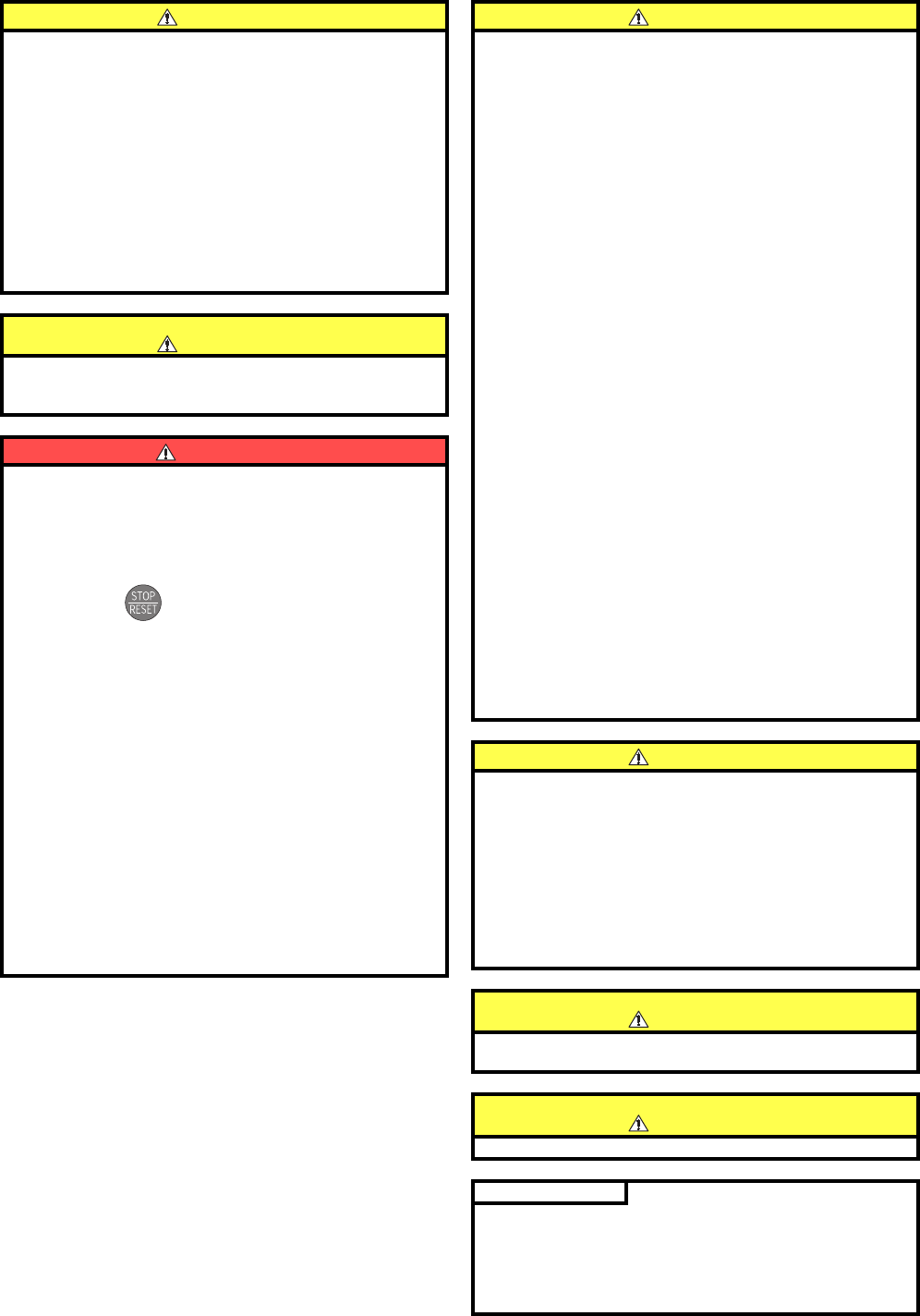
A-2
(2) Wiring
• Do not install a power factor correction capacitor, surge
suppressor or capacitor type filter on the inverter output side.
These devices on the inverter output side may be overheated or
burn out.
• The connection orientation of the output cables U, V, W to the
motor affects the rotation direction of the motor.
• IPM motor terminals (U, V, W) hold high-voltage while the IPM
motor is running even after the power is turned OFF. Before
wiring, the IPM motor must be confirmed to be stopped.
Otherwise you may get an electric shock.
• Never connect an IPM motor to the commercial power supply.
Applying the commercial power supply to input terminals (U,V,
W) of an IPM motor will burn the IPM motor. The IPM motor must
be connected with the output terminals (U, V, W) of the inverter.
(3) Test operation and adjustment
• Before starting operation, each parameter must be confirmed
and adjusted. A failure to do so may cause some machines to
make unexpected motions.
(4) Operation
• The IPM motor capacity must be same with the inverter capacity.
(The 0.75K inverter can be used with a one-rank lower MM-EF
motor.)
• Do not use multiple IPM motors with one inverter.
• Any person must stay away from the equipment when the retry
function is set as it will restart suddenly after trip.
• Since pressing key may not stop output depending on the
function setting status, separate circuit and switch that make an
emergency stop (power OFF, mechanical brake operation for
emergency stop, etc.) must be provided.
• OFF status of the start signal must be confirmed before resetting
the inverter fault. Resetting inverter alarm with the start signal
ON restarts the motor suddenly.
• Do not use an IPM motor in an application where a motor is
driven by its load and runs at a speed higher than the maximum
motor speed.
• A dedicated IPM motor must be used under IPM motor control.
Do not use a synchronous motor, induction motor, or
synchronous induction motor under IPM motor control.
• The inverter must be used for three-phase induction motors or
the dedicated IPM motor.
Connection of any other electrical equipment to the inverter
output may damage the equipment.
• Do not modify the equipment.
• Do not perform parts removal which is not instructed in this
manual. Doing so may lead to fault or damage of the inverter.
CAUTION
CAUTION
WARNING
• The electronic thermal relay function does not guarantee
protection of the motor from overheating. It is recommended to
install both an external thermal and PTC thermistor for overheat
protection.
• Do not use a magnetic contactor on the inverter input for
frequent starting/stopping of the inverter. Otherwise the life of
the inverter decreases.
• The effect of electromagnetic interference must be reduced by
using a noise filter or by other means. Otherwise nearby
electronic equipment may be affected.
• Appropriate measures must be taken to suppress harmonics.
Otherwise power supply harmonics from the inverter may heat/
damage the power factor correction capacitor and generator.
• When driving a 400V class motor by the inverter, the motor must
be an insulation-enhanced motor or measures must be taken to
suppress surge voltage. Surge voltage attributable to the wiring
constants may occur at the motor terminals, deteriorating the
insulation of the motor.
• When parameter clear or all parameter clear is performed, the
required parameters must be set again before starting
operations because all parameters return to the initial value.
• The inverter can be easily set for high-speed operation. Before
changing its setting, the performances of the motor and machine
must be fully examined.
• Stop status cannot be hold by the inverter's brake function. In
addition to the inverter's brake function, a holding device must
be installed to ensure safety.
• Before running an inverter which had been stored for a long
period, inspection and test operation must be performed.
• For prevention of damage due to static electricity, nearby metal
must be touched before touching this product to eliminate static
electricity from your body.
• Do not connect an IPM motor under the general-purpose motor
control settings (initial settings). Do not use a general-purpose
motor under the IPM motor control settings. Doing so will cause
a failure.
• In the system with an IPM motor, the inverter power must be
turned ON before closing the contacts of the contactor at the
output side.
(5) Emergency stop
• A safety backup such as an emergency brake must be provided
to prevent hazardous condition to the machine and equipment in
case of inverter failure.
• When the breaker on the inverter input side trips, the wiring must
be checked for fault (short circuit), and internal parts of the
inverter for a damage, etc. The cause of the trip must be
identified and removed before turning ON the power of the
breaker.
• When any protective function is activated, appropriate corrective
action must be taken, and the inverter must be reset before
resuming operation.
(6) Maintenance, inspection and parts replacement
• Do not carry out a megger (insulation resistance) test on the
control circuit of the inverter. It will cause a failure.
(7) Disposing of the inverter
• The inverter must be treated as industrial waste.
General instructions
Many of the diagrams and drawings in this Instruction Manual
(Basic) show the inverter without a cover or partially open for
explanation. Never operate the inverter in this manner. The cover
must be always reinstalled and the instruction in this Instruction
Manual (Basic) must be followed when operating the inverter.
For more details on a dedicated IPM motor, refer to the Instruction
Manual of the dedicated IPM motor.
CAUTION
CAUTION
CAUTION
CAUTION


















